Hermannia
Hermannia L.
Family: Malvaceae
Common names: doll's roses (Eng.); poprosie, moederkappie (Afr.)
Introduction
A very diverse and attractive group of plants with highly ornamental flowers, fitting into a variety of habitats and growth forms, hermannias are the little porcelain bells of the South African veld. These plants have high horticultural potential yet are sadly undervalued as a garden plant. In this issue, a few striking species of this genus will be discussed.
Description
Description
Hermannia is a genus of small shrubs, ranging from upright to sprawling prostrate shrublets. They are charachterized by the presence of minute glandular or star-like hairs on the leaves and stems. The stems often have a dark grey bark. Leaves are alternate and entire, lobed or incised. Flowers consist of 5 petals which are slightly or very strongly spirally twisted into an upended rose. Most Hermannia species posess a thick woody stem and root, forming an underground stem, which enables the plants to survive dry periods and fires. In the veld, hermannias appear woody, some species being very palatable to stock and browsed down to the main branches.

Conservation Status
Status
A taxonomic study of the genus has shown that a surprising number of species have a very limited distribution. This indicates that these distinct species are very restricted, giving rise to their diversity, but also making them more vulnerable in the case of over-utilization and disturbance.
Hermannias are generally common and not threatened. They have no specific value for collection, neither for the horticultural, nor medicinal trade.
Distribution and habitat
Distribution description
The genus consists of 154 species, which have a distribution mainly across the Flora of southern Africa area. There are 141 South African species alone, of which 81 are endemic to South Africa (occuring in South Africa only). The genus is also found in Madagascar, and extends through tropical East Africa (14 species, some shared with southern Africa) to North East Africa (four species, possibly more) and Arabia (one species, also found in Egypt and Sudan). A single species ( Hermannia tigrensis) is found in western Africa as well as southern Africa and North East Africa. There are three species in northern Mexico and adjacent parts of the United States, a single species in southern Mexico, and a single species in Australia. The greatest diversity is within the Western and Northern Cape and Namibia.
Derivation of name and historical aspects
History
The genus was named after Prof. Paul Herman (1640 - 1695), a German professor of botany at Leyden and one of the first travellers and collectors at the Cape.
Ecology
Ecology
Hermannias possess strong, thick, rootstocks and underground stems, which enable them to withstand fires in the highveld and overcome times of severe drought in arid areas. They are mostly very palatable to stock and small game, and are generally heavily grazed. Some species are an indication of good veld.
Uses
Use
Many members of the genus are used medicinally, for anything ranging from respiratory diseases, coughs and internal aches, as stimulants or purgatives, to soothing wounds and cuts. The common name pleisterbos ( Hermannia cuneifolia ) refers to the use of the leaves as plasters. In some plants the leaves are infused in a tea, and used to clean the blood. A root infusion was used by the early European colonial settlers against epilepsy. A lotion of the leaf was used for eczema and shingles. Certain species have magical significance and are used to drive out spirits and to wash the divining bones. H. depressa is used as a protective charm by the Zulus. H. hysopifolia is used in making an aromatic tea. Only one species has been found to be toxic to stock ( H. tomentosa ), but it is doubtful whether animals will browse this plant in the veld.
Growing Hermannia
Grow
Hermannias have great horticultural potential, but since they are generally associated with arid areas, the perception is that they only succeed in dry areas. However, it is well known that certain xerophytes thrive if given water with good drainage, so the group of plants is worth cultivating and testing. In the current times of climate change and water scarceness, it is important to cultivate these plants which are naturally adapted to less water. With the higher emphasis on water-wise gardening, plants with a wider ecological tolerance will assume increased importance in horticulture.
Many species of Hermannia are cultivated in some indigenous nurseries, as they have such excellent horticultural potential. However, they are still unknown to many gardeners, and need more publicity to increase their popularity.
Any garden can benefit from Hermannia plants. They can be planted for a dash of colour, as groundcovers, trailing from hanging baskets or as container plants. Their main requirements are good drainage and direct sun. The Cape species are frost-sensitive, and should not be planted in areas with severe, frosty winters.
Hermannias are best cultivated by taking hardwood or softwood cuttings during spring and early summer. Keep in a cool place and ensure good drainage. They are generally very easy to grow. Hermannias prefer full sun and will flower abundantly if watered well. Be careful though of over-watering the arid-loving species. Good drainage is essential.
Prune the plants during the winter by cutting away the old growth points. Since these plants respond excellently to grazing, pruning simulates grazing and stimulates prolific flowering.
Species
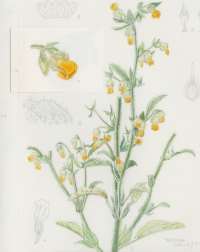
H. althaeifolia L.
Wolhaar-poproos, pokkiesblom, klokkiesbos, lanternbos (Afr.)
Softly hairy herb, annual to perennial, up to 500 mm tall, leaves are soft and hairy and coarsely toothed, flowers are bright yellow with a thick, softly hairy calyx. Flowering time: August to March.
Distribution: Fynbos and Succulent Karoo Biomes.
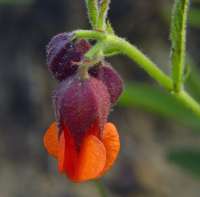
H. cristata Bolus
Small perennial shrub, with strong underground rhizome, to protect against fire. Stems are herby and half lying down, never taller than 200 mm. Flowers are single or in two's carried at the tip of the branchelts, dark red-orange (flame colour). Calyx reddish purple.
Distribution: widespread in the grasslands of the eastern Highveld.
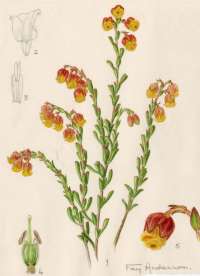
H. concinnifolia I.Verd.
Medium to tall shrub up to 900 mm high, branching at the base, ascending branches with narrow leaves neatly arranged on the branches. Petiole absent. The upper margins of the leaves sometimes with a narrow red-brown rim. Flowers arranged in two or three at the tip of the leafy branchlets. Lemon yellow flowers exserted from a red calyx, strongly twisted.
Distribution: coastal fynbos in the Bredasdorp-Riversdale District.
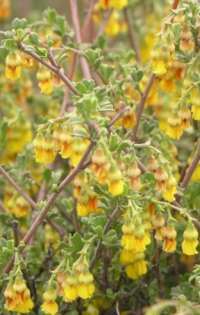
H. cuneifolia Jacq. var. cuneifolia.
Agtdaegeneesbossie, broodbos, geneesbossie, pleisterbos, geelpleisterbos, vet-en-broodbos (Afr.)
A sturdy, much-branched shrublet, up to 500 mm high. Leaves in tufts and coarsely toothed, both surfaces covered with star-like hairs. Flowers yellow, becoming red-brown with age, sweetly scented. Very palatable and drought resistant. This plant is used medicinally to heal wounds, therefore the name, geneesbos. Distribution: widespread in fynbos, karoo and grassland, from the Western Cape, Free State, to Lesotho.
H. depressa N.E.Br.
Rooi-opslag (Afr.)
Herb with stems and leaves flat on the ground and spreading from a woody perennial taproot. They often grow clumped in patches. The leaves are carried on short stalks, are generally large and show a purplish to reddish brown tinge. The flowers are drooping, from short erect stalks, and vary in colour between orange, pinkish, mauve and yellow-cream.
Distribution: common in grassland in the Highveld.
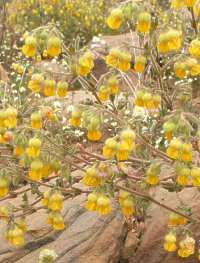
H. disermifolia Jacq.
Jeukbos (Afr.)
An erect, branched shrub, up to 1 m high. The long-stalked, yellow-green leaves are covered in minute, star-like hairs. Yellow flowers are borne in clusters towards the end of the branches. Plant is unpalatable to stock, and not eaten.
Distribution: This plant is restricted to the arid parts of Namaqualand and Namibia.
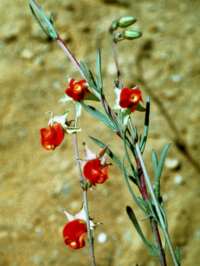
H. filifolia L.f. var. grandicalyx I.Verd.
Mooiblompleisterbos (Afr.)
Occuring in stony soils, shrublet with grey bark, leaves strap-shaped in clusters, hairless. Flowers in loose, spike-like groups at tips of branches. Corolla deep red to maroon. Very palatable to stock, higly resistant to droughts, responding very well after rain.
Distribution: central and Little Karoo.
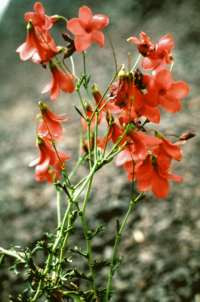
H. grandiflora Aiton.
Heuningbossie, ouma-se-kappie (Afr.)
Low, sprawling shrub, beautiful when in flower, covered with large red flowers, forming a solid round shrub. Leaves alternate with coarsely toothed margins. This plant is very palatable and its presence indicates good veld. A very good species for the arid, winter rainfall garden.
Distribution: throughout the Northern, Western and Eastern Cape.
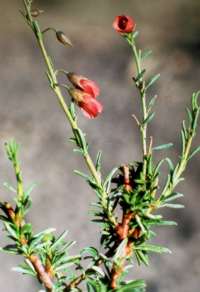
H. linearifolia Harv.
Rooipleisterbos (Afr.)
Bushy shrub, usually heavily browsed and appearing woody. The leaves are strap-shaped and are carried in tufts. Flowers small, 5-7 mm long, brick-red, and the petals are not as strongly twisted as the other Hermannia species. Very drought resistant.
Distribution: arid parts of the country from the Little Karoo to the Free State and Northern Cape.
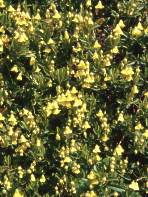
Hermannia saccifera (Turcz.) K. Schum.
A low, sprawling, strangling shrublet up to 400 mm high. The leaves are smooth, hairless, shiny, regularly toothed and bright green. The flowers, usually 2 per peduncle, are bright yellow, pendulous and bell-shaped.
Distribution: along the southern coast, from the Riviersonderend Mountains and Bredasdorp in the Western Cape to Uitenhage in the Eastern Cape.
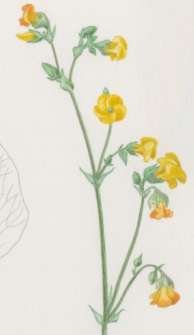
H. prismatocarpa E.Mey. ex Harv.
A lax, low-growing shrub, with long branches sprawling on the ground, and the flowering tips bending upwards. Leaves are ovoid, with minute, star-like hairs. Flowers are lemon-yellow, and sparsely arranged on the branchlets.
Distribution: from the Cape Peninsula northwards to Vanrhynsdorp and eastwards to the coast.

H. stricta (E.Mey. ex Turcz.) Harv.
Desert rose (Eng); rooi-opslag, woestynroos (Afr.)
Perennial shrub up to 800 mm high. When not in flower it appears woody with a grey bark. Flowers are drooping, dark pink with the petals spirally overlapping and flaring out in an open trumpet. Very attractive when in full bloom.
Distribution: Northern and Western Cape and Namibia.
References
- Dyer, R.A. 1954. Hermannia cristata. The Flowering Plants of Africa 30: t. 1169.
- Germishuizen,G. & Meyer, N.L. (eds). 2003. Plants of southern Africa : an annotated checklist. Strelitzia 14. National Botanical Institute, Pretoria.
- Le Roux, A. 2005. Namaqualand. South African Wild Flower Guide 1. Botanical Society of South Africa, Cape Town.
- Le Roux, P.M., Kotze, C.D., Nel, G.P. & Glen, H.F. 1994. Bossieveld. Grazing plants of the Karoo and karoo-like areas. Bulletin No. 428. Department of Agriculture, Pretoria.
- Manning, J. & Goldblatt, P. 1996. Weskus. South African Wild Flower Guide 7. Botanical Society of South Africa, Cape Town.
- Rood, B. 1994. Uit die veldapteek. Tafelberg, Cape Town.
- Smith, C.A. 1966. Common names of South African plants. Memoirs of the Botanical Survey of South Africa No. 35.
- Van Rooyen, G. & Steyn, H. 1999. Cederberg. South African Wild Flower Guide 10. Botanical Society of South Africa, Cape Town.
- Van Wyk, B. & Malan, S. 1988. Field guide to the wild flowers of the Highveld. Struik, Cape Town.
- Verdoorn, I.C. 1971. Hermannia prismatocarpa. The Flowering Plants of Africa 41: t. 1628.
- Verdoorn, I.C. 1974. Hermannia concinnifolia. The Flowering Plants of Africa 43: t. 1691.
- Verdoorn, I.C. 1980. Revision of Hermannia subgenus Hermannia in southern Africa. Bothalia 13: 1-63.
- Verdoorn, I.C. 1986. Hermannia grandiflora. The Flowering Plants of Africa 49: t. 1922.
- Watt, J.M. & Breyer-Brandwijk, M.G. 1962. The medicinal and poisonous plants of southern and eastern Africa, edn 2. Livingstone, London.
Credits
Beate Sachse
National Herbarium, Pretoria
December 2007
Plant Attributes:
Plant Type: Shrub
SA Distribution:
Soil type:
Flowering season:
PH:
Flower colour:
Aspect:
Gardening skill:
Special Features:
Horticultural zones






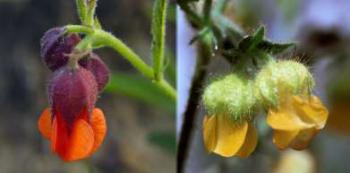
Rate this article
Article well written and informative
Rate this plant
Is this an interesting plant?
Login to add your Comment
Back to topNot registered yet? Click here to register.